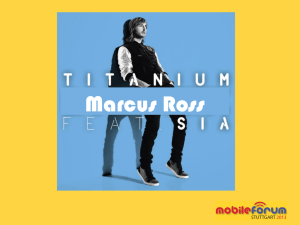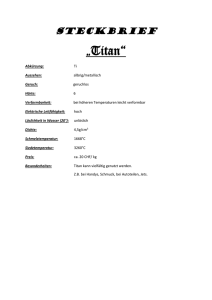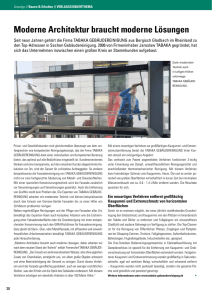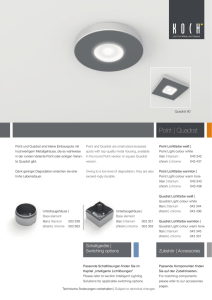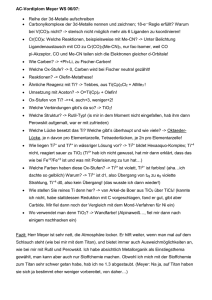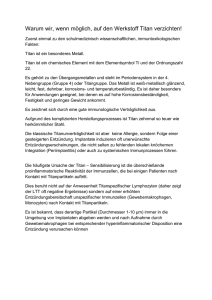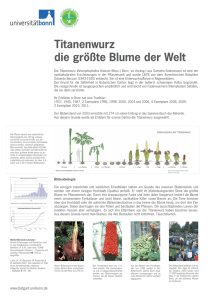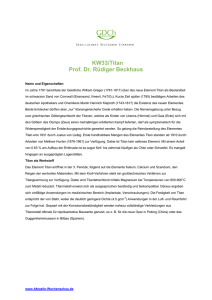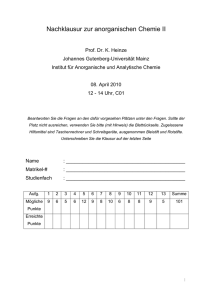Ti - IndustryStock
Werbung
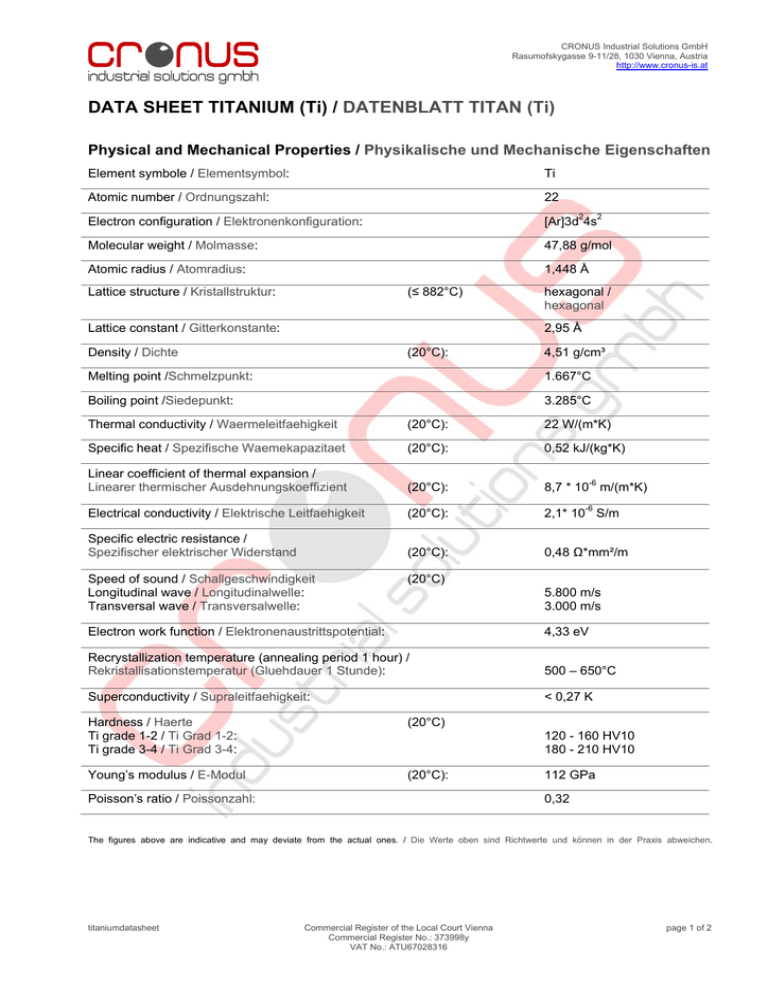
CRONUS Industrial Solutions GmbH Wien Österreich Rasumofskygasse 9-11/28, 1030 Vienna, Austria http://www.cronus-is.at DATA SHEET TITANIUM (Ti) / DATENBLATT TITAN (Ti) Physical and Mechanical Properties / Physikalische und Mechanische Eigenschaften Element symbole / Elementsymbol: Ti Atomic number / Ordnungszahl: 22 Electron configuration / Elektronenkonfiguration: [Ar]3d24s2 Molecular weight / Molmasse: 47,88 g/mol Atomic radius / Atomradius: 1,448 Å Lattice structure / Kristallstruktur: (≤ 882°C) Lattice constant / Gitterkonstante: hexagonal / hexagonal 2,95 Å Density / Dichte (20°C): 4,51 g/cm³ Melting point /Schmelzpunkt: 1.667°C Boiling point /Siedepunkt: 3.285°C Thermal conductivity / Waermeleitfaehigkeit (20°C): 22 W/(m*K) Specific heat / Spezifische Waemekapazitaet (20°C): 0,52 kJ/(kg*K) Linear coefficient of thermal expansion / Linearer thermischer Ausdehnungskoeffizient (20°C): 8,7 * 10-6 m/(m*K) Electrical conductivity / Elektrische Leitfaehigkeit (20°C): 2,1* 10-6 S/m Specific electric resistance / Spezifischer elektrischer Widerstand (20°C): 0,48 Ω*mm²/m Speed of sound / Schallgeschwindigkeit Longitudinal wave / Longitudinalwelle: Transversal wave / Transversalwelle: (20°C) 5.800 m/s 3.000 m/s Electron work function / Elektronenaustrittspotential: 4,33 eV Recrystallization temperature (annealing period 1 hour) / Rekristallisationstemperatur (Gluehdauer 1 Stunde): 500 – 650°C Superconductivity / Supraleitfaehigkeit: < 0,27 K Hardness / Haerte Ti grade 1-2 / Ti Grad 1-2: Ti grade 3-4 / Ti Grad 3-4: (20°C) Young’s modulus / E-Modul (20°C): 120 - 160 HV10 180 - 210 HV10 Poisson’s ratio / Poissonzahl: 112 GPa 0,32 The figures above are indicative and may deviate from the actual ones. / Die Werte oben sind Richtwerte und können in der Praxis abweichen. titaniumdatasheet Commercial Register of the Local Court Vienna Commercial Register No.: 373998y VAT No.: ATU67028316 page 1 of 2 CRONUS Industrial Solutions GmbH Wien Österreich Rasumofskygasse 9-11/28, 1030 Vienna, Austria http://www.cronus-is.at Chemical Properties Chemische Eigenschaften Titanium is found in group 4 of the periodic table of elements together with zirconium and hafnium. Most stable oxidation state is +4. Titan steht gemeinsam mit Zirkonium und Hafnium in der „Titangruppe“. Die stabilste Oxidationsstufe ist die Stufe +4. One of the main characteristics is the excellent corrosion resistance of titanium against diluted acids and alkalis since titanium spontaneously forms a thin protective oxide layer at the presence of air or water. Charakteristische Eigenschaft des Titans ist seine Korrosionsbestaendigkeit gegen verduennte Saeuren und Laugen, die sich dadurch erklaert, dass es in Gegenwart von Luft oder Wasser sofort eine duenne Oxidschicht ausbildet. However, at high temperatures titanium readily reacts with oxygen to titanium dioxide (TiO2). As a result melting is only possible in an inert atmosphere or vacuum. Titanium also reacts with other non-metals to TiC, TiN, TiH2, TiCl4, etc. Bei Erhitzen verbrennt es allerdings lebhaft zum Dioxid (TiO2). Aus diesem Grund kann Titan nur unter Schutzgasatmosphaere geschmolzen werden. Ebenso reagiert es mit anderen Nichtmetallen zu TiC, TiN, TiH2, TiCl4, usw. Occurrence and Production Vorkommen und Darstellung Titanium is mainly found in iron ores, namely in ilmenite. Further minerals are titanite, perovskite and TiO2 (rutile, anatase, brookite). Man findet Titan hauptsaechlich in Eisenerzen, namentlich im Ilmenit, außerdem als Titanit, Perowskit und als TiO2 (Rutil, Anatas, Brookit). Due to the fact that titanium forms carbides, titanium cannot be obtained from the reduction of the oxide with carbon. In a first step, the production comprises the conversion of the oxide into the chloride (TiCl4) with chlorine and coke at 800 degrees Celsius. By means of the “Kroll process” TiCl4 is processed with magnesium and as a result of this reduction step the so-called titanium sponge is obtained. The titanium sponge is finally re-melted in a vacuum arc furnace. Da Titan ein Carbidbildner ist, kann das Metall nicht aus der Reduktion des Oxids mit Kohlenstoff hergestellt werden. Die technische Darstellung erfolgt demnach über TiCl4, welches durch Umsetzung mit Chlor und Koks bei 800°C hergestellt wird. Der sogenannte Titanschwamm wird dann mittels „Kroll-Prozess“ durch Reduktion mit Magnesium erhalten. Der Titanschwamm wird dann im Vakuum-Lichtbogenofen umgeschmolzen. Main Grades and Alloys / Wichtige Sorten und Legierungen % Al V Pd Mo Ni C≤ N≤ H≤ O≤ Fe ≤ Ti 1 (3.7025) - - - - - 0,08 0,03 0,015 0,18 0,20 Ti 2 (3.7035) - - - - - 0,08 0,03 0,015 0,25 0,30 Ti 5 (3.7165) 5,5-6,75 3,5-4,5 - - - 0,08 0,03 0,015 0,20 0,40 Ti 7 (3.7235) - - 0,15-0,25 - - 0,08 0,03 0,015 0,25 0,30 Ti 9 (3.7194) 2,5-3,5 2,0-3,0 - - - 0,08 0,03 0,015 0,15 0,25 Ti 11 (3.7225) - - 0,15-0,25 - - 0,08 0,03 0,015 0,18 0,20 Ti 12 (3.7105) - - - 0,2-0,4 0,6-0,9 0,08 0,03 0,015 0,25 0,30 Ti 16 - - 0,04-0,08 - - 0,08 0,03 0,015 0,25 0,30 Ti 17 - - 0,04-0,08 - - 0,08 0,03 0,015 0,18 0,20 Ti 23 5,5-6,75 3,5-4,5 -- - 0,08 0,05 0,015 0,13 0,25 Ti 26 - - - 0,08-0,14 - - 0,08 0,03 0,015 0,25 0,30 Ti 27 - - - 0,08-0,14 - - 0,08 0,03 0,015 0,18 0,20 Ti … balance / others … ≤ 0,4% / other alloys upon request titaniumdatasheet Ru / Ti … Differenz / andere … ≤ 0,4% / andere Legierungen auf Nachfrage Commercial Register of the Local Court Vienna Commercial Register No.: 373998y VAT No.: ATU67028316 page 2 of 2
